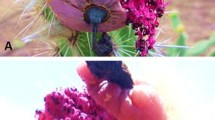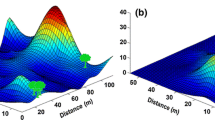Abstract
Seed dispersal is a critical stage in the life history of plants. It determines the initial pattern of juvenile distribution, and can influence community dynamics and the evolutionary trajectories of individual species. Vertebrate frugivores are the primary vector of seed dispersal in tropical forests; however, most studies of seed dispersal focus on birds, bats and monkeys. Nevertheless, South America harbors at least 200 species of frugivorous fishes, which move into temporarily flooded habitats during lengthy flood seasons and consume fruits that fall into the water; and yet, we know remarkably little about the quality of seed dispersal they effect. We investigated the seed dispersal activities of two species of large-bodied, commercially important fishes (Colossoma macropomum and Piaractus brachypomus, Characidae) over 3 years in Pacaya-Samiria National Reserve (Peru). We assessed the diet of these fishes during the flood season, conducted germination trials with seeds collected from digestive tracts, and quantified fruit availability. In the laboratory, we fed fruits to captive Colossoma, quantified the proportion of seeds defecated by adult and juvenile fish, and used these seeds in additional germination experiments. Our results indicate that Colossoma and Piaractus disperse large quantities of seeds from up to 35% of the trees and lianas that fruit during the flood season. Additionally, these seeds can germinate after floodwaters recede. Overexploitation has reduced the abundance of our focal fish species, as well as changed the age structure of populations. Moreover, older fish are more effective seed dispersers than smaller, juvenile fish. Overfishing, therefore, likely selects for the poorest seed dispersers, thus disrupting an ancient interaction between seeds and their dispersal agents.



Similar content being viewed by others
References
Araujo-Lima C, Goulding M (1997) So fruitful a fish: conservation and aquaculture of the Amazon’s Tambaqui. Columbia University Press, New York City
Banack SA, Horn MH, Gawlicka A (2002) Disperser- vs. establishment-limited distribution of a riparian fig tree (Ficus insipida) in a Costa Rican Tropical Rain forest. Biotropica 34:232–243
Bayley P, Petrere M (1989) Amazon fisheries: assessment methods, current status and management options. In: Dodge DP (ed) Proceedings of the International Large River Symposium, vol 106. Can Spec Publ Fish Aquat Sci, Ottowa, pp 385–398
Chapman CA (1989) Primate seed dispersal: the fate of dispersed seeds. Biotropica 21:148–154
Connell JH (1971) On the role of natural enemies in preventing competitive exclusion in some marine mammals and in rain forest trees. In: Boer PJ, Gradwell G (eds) Dynamics of populations. PUDOC, Wageningen, pp 298–310
Correa SB, Winemiller KO, López-Fernández H, Galetti M (2007) Evolutionary perspectives on seed consumption and dispersal by fishes. Bioscience 57:748–756
Cox DR (1972) Regression models and life-tables. J R Stat Soc Ser B (Methodol) 34:187–220
Dahdul W (2004) Fossils of the Miocene Castillo formation, Venezuela: contributions on neotropical paleontology. In: Sánchez-Villagra M, Clack JA (eds) Special papers in paleontology series. Palaeontological Association, London, pp 23–28
de Carvalho Gomes L, Campos Chagas E, Martins-Junior H, Roubach R, Akifumi Ono E, de Paula Lourenço J (2006) Cage culture of tambaqui (Colossoma macropomum) in a central Amazon floodplain lake. Aquaculture 253:374–384
Estrada A, Coates-Estrada R, Vazquez-Yanes C (1984) Observations on fruiting and dispersers of Cecropia obtusifolia at Los Tuxtlas, Mexico. Biotropica 16:315–318
Eva HD, et al. (2004) A land cover map of South America. Glob Change Biol 10:731–744
Fleming TH, Williams CF (1990) Phenology, seed dispersal, and recruitment in Cecropia peltata (Moraceae) in Costa Rican tropical dry forest. J Trop Ecol 6:163–178
Galetti M, Donatti CI, Aurélio Pizo M, Giacomini (2008) Big fish are the best: seed dispersal of Bactris glaucescens by the Pacu fish (Piaractus mesopotamicus) in the Pantanal, Brazil. Biotropica 40:386–389
Garnier LKM, Durand J, Dajoz I (2002) Limited seed disperal and microspatial population structure of an agamospermous grass of West African savannahs, Hyparrhenia diplandra (Poaceae). Am J Bot 89:1785–1791
Gibson JP, Wheelwright NT (1995) Genetic structure in a population of a tropical tree Ocotea tenera (Lauraceae): influence of avian seed dispersal. Oecologia 103:49–54
Goulding M (1980) The fishes and the forest: explorations in Amazonian natural history. University of California Press, Berkeley
Goulding M (1993) Flooded forests of the Amazon. Sci Am 268:114–120
Goulding M, Smith NJH, Mahar DJ (1996) Floods of fortune: ecology and economy along the Amazon. Columbia University Press, New York
Haugaasen T, Peres CA (2007) Vertebrate responses to fruit production in Amazonian flooded and unflooded forests. Biodiv Conserv 16:4165–4190
Heinze G, Schemper M (2002) A solution to the problem of separation in logistic regression. Stat Med 21:2409–2419
Horn MH (1997) Evidence for dispersal of fig seeds by the fruit-eating characid fish Brycon guatemalensis Regan in a Costa Rican tropical rain forest. Oecologia 109:259–264
Howe HF, Smallwood J (1982) Ecology of seed dispersal. Annu Rev Ecol Syst 13:201–228
Isaac VJ, Ruffino ML (1996) Population dynamics of tambaqui, Colossoma macropomum Cuvier, in the Lower Amazon, Brazil. Fish Manage Ecol 3:315–333
Janzen D (1970) Herbivores and the number of tree species in tropical forests. Am Nat 104:501–528
Jordano P (1995) Angiosperm fleshy fruits and seed dispersers: a comparative analysis of adaptation and constraints in plant-animal interactions. Am Nat 145:163–188
Jordano P, García C, Godoy JA, García-Castaño JL (2007) Differential contribution of frugivores to complex seed dispersal patterns. Proc Natl Acad Sci USA 104:3278–3282
Junk WJ (1985) Temporary fat storage, an adaptation of some fish species to the waterlevel fluctuations and related environmental changes of the Amazon River. Amazoniana 9:315–351
Junk W, Soares M, Saint-Paul U (1997) The fish. In: Junk W (ed) The central Amazon Floodplain: ecology of a pulsing system. Springer, Berlin, pp 385–408
Kubitzki K, Ziburski A (1994) Seed dispersal in flood plain forests of Amazonia. Biotropica 26:30–43
Kvist LP, Nebel G (2001) A review of Peruvian flood plain forests: ecosystems, inhabitants and resource use. For Ecol Manage 150:3–26
Levey DJ, Bolker BM, Tewksbury JJ, Sargent S, Haddad NM (2005) Effects of landscape corridors on seed dispersal by birds. Science 309:146–148
Littell RC, Henry PR, Ammerman CB (1998) Statistical analysis of repeated measures data using SAS procedures. J Anim Sci 76:1216–1231
Lobova TA, Mori SA, Blanchard F, Peckham H, Charles-Dominique P (2003) Cecropia as a food resource for bats in French Guiana and the significance of fruit structure in seed dispersal and longevity. Am J Bot 90:388–403
Lowe-McConnell RH (1987) Ecological studies in tropical fish communities. Cambridge University Press, Cambridge
Lucas C (2008) Within flood season variation in fruit consumption and seed dispersal by two characin fishes of the Amazon. Biotropica 40:581–589
Lundberg JG, Machado-Allison A, Kay RF (1986) Miocene characid fishes from Colombia: evolutionary stasis and extirpation. Science 234:208–209
Lundberg JG, Kottelat M, Smith GR, Stiassny MLJ, Gill AC (2000) So many fishes, so little time: an overview of recent ichthyological discovery in continental waters. Ann Mo Bot Gard 87:26–62
Makrakis MC, Miranda LE, Makrakis S, Xavier AMM, Fontes HM, Morlis WG (2007) Migratory movements of pacu, Piaractus mesopotamicus, in the highly impounded Parana River. J Appl Ichthyol 23:700–704
Mannheimer S, Bevilacqua G, Caramaschi EP, Scarano FR (2003) Evidence for seed dispersal by the catfish Auchenipterichthys longimanus in an Amazonian lake. J Trop Ecol 19:215–218
Murray KG (1988) Avian seed dispersal of three neotropical gap-dependent plants. Ecol Monogr 58:271–298
Nathan R, Muller-Landau HC (2000) Spatial patterns of seed dispersal, their determinants and consequences for recruitment. Trends Ecol Evol 15:278–285
Oliveira ACB, Martinelli LA, Moreira MZ, Soares MGM, Cyrino JEP (2006) Seasonality of energy sources of Colossoma macropomum in a floodplain lake in the Amazon—lake Camaleão, Amazonas, Brazil. Fish Manage Ecol 13:135–142
Paine CET, Beck H (2007) Seed predation by neotropical rain forest mammals increases diversity in seedling recruitment. Ecology 88:3076–3087
Parolin P, et al. (2004) Central Amazonian floodplain forests: tree adaptations in a pulsing system. Bot Rev 70:357–380
Reinert TR, Winter KA (2002) Sustainability of harvested pacú (Colossoma macropomum) populations in the Northeastern Bolivian Amazon. Conserv Biol 16:1344–1351
Russo SE, Augspurger C (2004) Aggregated seed dispersal by spider monkeys limits recruitment to clumped patterns in Virola calophylla. Ecol Lett 7:1058–1067
Saint-Paul U, et al. (2000) Fish communities in central Amazonian white- and blackwater floodplains. Environ Biol Fish 57:235–250
Samuels IA, Levey DJ (2005) Effects of gut passage on seed germination: do experiments answer the questions they ask? Funct Ecol 19:365–368
Santos MCF, Ruffino ML, Farias IP (2007) High levels of genetic variability and panmixia of the tambaqui Colossoma macropomum (Cuvier, 1816) in the main channel of the Amazon River. J Fish Biol 71:33–44
Schupp EW (1993) Quantity, quality and the effectiveness of seed dispersal by animals. Vegetation 107/108:15–29
Seidler T, Plotkin JB (2006) Seed dispersal and spatial pattern in tropical trees. Public Libr Sci Biol 4:2132–2137
Stoner K, Vulinec K, Wright SJ, Peres CA (2007) Hunting and plant community dynamics in tropical forests: a synthesis. Biotropica 39:385–392
Ter Steege H, Sabatier D, Castellanos H, Van Andel T, Duivenvoorden J, Adalardo A, de Oliveira R, Ek R, Lilwah R, Maas P, Mori S (2000) An analysis of the floristic composition and diversity of Amazonian forests including those of the Guiana Shield. J Trop Ecol 16:801–828
Tobler M, Honorio E, Janovec J, Reynel C (2007) Implications of collection patterns of botanical specimens on their usefulness for conservation planning: an example of two neotropical plant families (Moraceae and Myristicaceae) in Peru. Biodivers Conserv 16:659–677
Traveset A, Rodríguez-Pérez J, Píaz B (2008) Seed trait changes in dispersers’ guts and consequences for germination and seedling growth. Ecology 89:95–106
Wehncke EV, Dalling JW (2005) Post-dispersal seed removal and germination selected tree species dispersed by Cebus capucinus on Barro Colorado Island, Panama. Biotropica 37:73–80
Wenny DG, Levey DJ (1998) Directed seed dispersal by bellbirds in a tropical cloud forest. Proc Natl Acad Sci USA 95:6204–6207
Acknowledgements
Funding for this study was provided by the Wildlife Conservation Society, the National Geographic Society (grant no. 7979-06), and the Cornell Center for the Environment. Animal care protocols were approved by the Cornell University Institutional Animal Care and Use Committee. F. Vermeylen helped with the statistical analyses. C. del Busto Rojas, J. Barrera Macedo, J. Vásquez, R. Rosales, S. Vázquez, S. Pérez, L. Ramírez, E. Yumbato, A. Sima, O. Yumbato, and V. Saldaña provided assistance in the field. We thank M. Geber and lab, P. Marks, T. Pendergast, M. Vellend, J. Bellemare, J. Shykoff and two anonymous reviewers for constructive criticisms on previous drafts of the manuscript. We would like to thank the Instituto Nacional de Recursos Naturales (Peru), the Ministerio de la Producción (Peru), and the Ministerio de Agricultura y Cria (Venezuela) for permits to conduct this research and the Instituto para la Investicación de la Amazonia Peruana (Peru) for logistical support. This study complies with the laws of Peru and Venezuela.
Author information
Authors and Affiliations
Corresponding author
Additional information
Communicated by Jacqui Shykoff.
Electronic supplementary material
Below is the link to the electronic supplementary material.
Rights and permissions
About this article
Cite this article
Anderson, J.T., Saldaña Rojas, J. & Flecker, A.S. High-quality seed dispersal by fruit-eating fishes in Amazonian floodplain habitats. Oecologia 161, 279–290 (2009). https://doi.org/10.1007/s00442-009-1371-4
Received:
Accepted:
Published:
Issue Date:
DOI: https://doi.org/10.1007/s00442-009-1371-4




